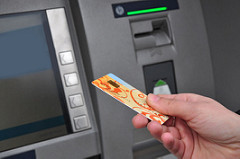
David Lerner Associates:What You Should Know About ATM Skimming
The scam is known as ATM skimming — here’s how it works: Thieves install a device called an ATM skimmer on top of the card reader on a legitimate ATM, which records the information on debit and credit cards’ magnetic stripes. They also install a tiny pinhole camera somewhere on the ATM — for example, on a disguised pamphlet holder — which records PINs as they are entered by unsuspecting victims.
Once they retrieve the skimmers, thieves can download the stolen mag stripe data and program it onto fake debit and credit cards they produce themselves. Armed with the PINs captured on the pinhole camera, the thieves now have all they need to wipe out cardholders’ bank accounts.
If you’re thinking that ATM skimmers are big, bulky devices that are easy to spot, think again. Most of them fit neatly over the top of the card reader and are designed to match the look of the ATM itself, making them almost undetectable at a quick glance or to an ATM user who is not familiar with them.
ATM fraud in the U.S. accounts for an estimated $350,000 in losses every day, or more than $1 billion a year, and 80 percent of this is attributable to ATM skimming. While Europe and many other countries have switched their card payment systems to a more secure EMV microchip standard, this hasn’t happened yet in the U.S., where mag stripe technology is still predominant. Experts say this is one factor that’s driving the increased incidences of ATM skimming here in the U.S. as overseas thieves shift their attention here.
Here are three steps you can take to help protect yourself from ATM skimming:
1. Use your other hand to shield your fingers as you type in your PIN.Experts say taking this one simple step could practically eliminate ATM skimming. This is because if the hidden camera can’t capture your PIN, the mag stripe data captured by the skimmer is useless to the thief.
2. Examine an ATM carefully before inserting your card.While skimmers may be hard for the untrained eye to spot, they actually become pretty obvious if you’re on the lookout for them. They usually consist of an extra piece of plastic that sits atop the slot where you insert your ATM card. They’re usually attached to the ATM using two-sided tape, so if it looks suspicious, jiggle it a little — if it’s loose, it might be a skimmer.
3. Don’t use ATMs in secluded, low-traffic areas.It takes a few minutes for thieves to install skimmers, so they usually choose ATMs in more secluded areas with less foot traffic so they’re less likely to be seen. If possible, try to only use ATMs in high-traffic areas like grocery stores, the mall or outside the bank itself.
If you are a victim of ATM skimming, the amount of your potential loss depends on the kind of card you used and how quickly you reported the fraud. Credit card losses due to fraud are capped at $50, but debit card losses could be unlimited if you don’t report the fraud in a timely manner. If you report the fraud within two business days, the loss is capped at $50, while it’s capped at $500 if you report the fraud in between 3 and 60 days. After 60 days, the loss could be unlimited.
Material contained in this article is provided for information purposes only and is not intended to be used in connection with the evaluation of any investments offered by David Lerner Associates, Inc. This material does not constitute an offer or recommendation to buy or sell securities and should not be considered in connection with the purchase or sale of securities. Member FINRA & SIPC.

